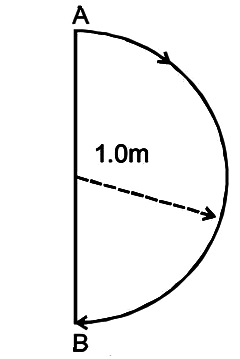A body of mass 2 kg is moved from a point A to a point B by an external agent in a conservative force field. If the velocity of the body at the points A and B are and respectively and the work done by the external agent is - 10 J, then the change in potential energy between point A and B is
6 J
36 J
16 J
None of these
The correct Answer is:A
To find the change in potential energy between points A and B, we can use the work-energy principle, which states that the work done by the external agent is equal to the change in total mechanical energy (kinetic + potential energy) of the body.
1. Identify the given values:
- Mass of the body, m=2kg
- Velocity at point A, vA=5m/s
- Velocity at point B, vB=3m/s
- Work done by the external agent, W=−10J
2. Calculate the initial kinetic energy (KE) at point A:
KEA=12mv2A=12×2×(5)2=12×2×25=25J
3. Calculate the final kinetic energy (KE) at point B:
KEB=12mv2B=12×2×(3)2=12×2×9=9J
4. Use the work-energy principle:
The work done by the external agent is equal to the change in mechanical energy:
W=KEB+PEB−(KEA+PEA)
Rearranging gives:
ΔU=W+(KEA−KEB)
5. Substituting the values:
ΔU=−10+(25−9)
ΔU=−10+16=6J
6. Conclusion:
The change in potential energy between point A and B is ΔU=6J.
- Mass of the body, m=2kg
- Velocity at point A, vA=5m/s
- Velocity at point B, vB=3m/s
- Work done by the external agent, W=−10J
KEA=12mv2A=12×2×(5)2=12×2×25=25J
KEB=12mv2B=12×2×(3)2=12×2×9=9J
The work done by the external agent is equal to the change in mechanical energy:
W=KEB+PEB−(KEA+PEA)
Rearranging gives:
ΔU=W+(KEA−KEB)
ΔU=−10+(25−9)
ΔU=−10+16=6J
The change in potential energy between point A and B is ΔU=6J.
Topper's Solved these Questions
- WORK, POWER AND ENERGYBook:DC PANDEY ENGLISHChapter:WORK, POWER AND ENERGYExercise:B More than One Option is Correct
Explore 26 Videos
- WORK, POWER AND ENERGYBook:DC PANDEY ENGLISHChapter:WORK, POWER AND ENERGYExercise:C Comprehension Type Questions
Explore 18 Videos
- WORK, POWER AND ENERGYBook:DC PANDEY ENGLISHChapter:WORK, POWER AND ENERGYExercise:E Integer Type Questions
Explore 11 Videos
- WORK, ENERGY AND POWERBook:DC PANDEY ENGLISHChapter:WORK, ENERGY AND POWERExercise:MEDICAL ENTRACES GALLERY
Explore 33 Videos
Similar Questions
A body is moving with constant acceleration, a=5ms2 from A to B in straight line AB. The velocity of particle at A and B are 5 m/s and 15 m/s respectively. The velocity at mid-point of AB is
View SolutionA body of mass 2 kg fall vertically, passing through two points A and B. The speeds of the body as it passes A and B are 1 m/s and 4m/s respectively. The resistance against which the body falls is 9.6N. What is the distance AB?
View SolutionA ball of mass 1g and charge 10−8C moves from a point A. Where potential is 600 volt to the point B where potential is zero. Velocity of the ball at the point B is 20cm/s. The velocity of the ball at the point A will be
View SolutionA charge is moved in an electric field of a fixed charge distribution from point A to another point B slowly. The work done by external agent in doing so is 100J. What is the change in potential energy of the charge as it moves from A to B ? What is the work done by the electric field of the charge distribution as the charge moves from A to B ?
View SolutionA charge is moved in an electric field of a fixed charge distribution from point A to another point B slowly. The work done by external agent in doing so is 100J . What is the change in potential energy of the charge as it moves from A to B ? What is the work done by the electric field of the charge distribution as the charge moves from A to B ?
View SolutionFind the work done by some external force in moving a charge q=2μC from infinity to a point where electric potential is 104 V.
View SolutionIn 1.0s, a particle goes from point A to point B , moving in a semicircle of radius 1.0m (see figure ). The magnitude of the average velocity

View SolutionIn 1.0s, a particle goes from point A to point B , moving in a semicircle of radius 1.0m (see figure ). The magnitude of the average velocity

View SolutionIn 1.0 s, a particle goes from point A to point B, moving in a semicircle of radius 1.0 m. The magnitude of the average velocity is :-
View SolutionWork done by a conservative force in bringing a body from infinity to A is 60 J and to B is 20J. What is the difference in potential energy between point A and B, i.e. UB−UA.
View Solution
